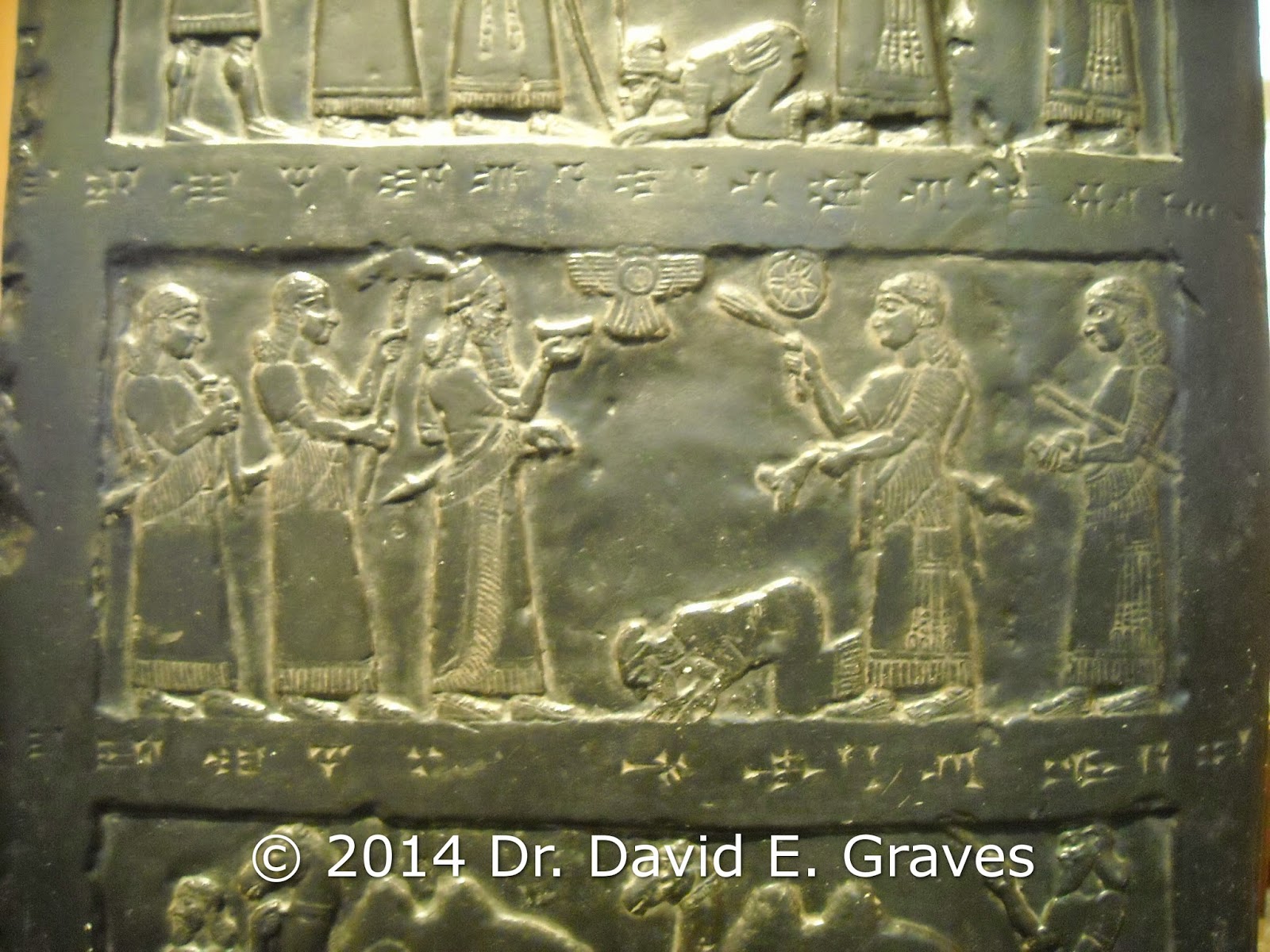 |
| Replica of the Black Obelisk on display in the Oriental Institute Museum University of Chicago. The original is in the British Museum ME 118885. |
Viewing the text in a clockwise direction it translates as:
1. Sua of Gilzanu (Northwest Iran): "I received tribute from Sua, the Gilzanean: silver, gold, tin, bronze casseroles, the staffs of the king’s hand, horses and two-humped camels."
2. Jehu of Bit Omri (Jehu of the House of Omri – Northern Kingdom of Israel): "I received tribute from Jehu, son of Omri: silver, gold, a gold bowl, a gold tureen, gold vessels, gold pails, tin, the staffs of the king’s hand, and spears.
3. An unnamed ruler of Musri (Egypt?): "I received tribute from Egypt: two-humped camels, a water buffalo, a rhinoceros, an antelope, female elephants, female monkeys and apes."
4. Marduk-apil-usur of Suhi (middle Euphrates): "I received tribute from Marduk-apla-utsur, the Suhean: silver, gold, gold pails, ivory, spears, byssus, garments with multicolored trim and linen garments."
5. Qalparunda of Patin (Antakya region of Turkey): "I received tribute from Qarparunda, the Patinean: silver, gold, tin, bronze compound, bronze utensils, ivory and ebony."1
More importantly while there are other Assyrian and Babylonian texts that mention Hebrew kings, this obelisk depicts the earliest surviving picture of an Israelite king. One of the panel’s depicts the Israelite King Jehu bringing tribute to King Shalmaneser III in around 841 BC.
However, while the Black Obelisk states that Jehu is the son of Omri, 2 Kings 9:2, 14 states that Jehu is the son of Jehoshaphat, the son of Nimshi. How does one reconcile this apparent contradiction? There are three possible proposed solutions.
- One of the two accounts is inaccurate. Either the Black Obelisk is inaccurate as our modern newspapers are often in error 2. or biblical critics would say the Bible is inaccurate.
- Kyle McCarter challenges the reading of the Black Obelisk that it is not Jehu but is actually referring to Jehoram (Joram), the grandson of King Omri whom Jehu killed. 3. However, Gallil dismisses this interpretation on linguistic grounds.4.
- Tammi Schneider argues that Jehu may have been a descendant of Omri. 5.
 |
One of the panel’s of the Black Obelisk depicts the Israelite King Jehu bringing tribute to King Shalmaneser III in around 841 BC |
Footnotes
- 1. Bill T. Arnold and Bryan E. Beyer, Readings from the Ancient Near East: Primary Sources for Old Testament Study, Encountering Biblical Studies (Grand Rapids, MI: Baker Academic, 2002), 144–45. See also James Bennett Pritchard, ed., The Ancient Near East, Volume 1: An Anthology of Texts and Pictures (Princeton, N.J.: Princeton University Press, 1973), 192.
- 2. Hal Flemings, Examining Criticisms of the Bible (Bloomington, IN: AuthorHouse, 2008), 109.
- 3. P. Kyle McCarter, “ ’Yaw, Son of ‘Omri’: A Philological Note on Israelite Chronology,” Bulletin of the American Schools of Oriental Research, no. 216 (December 1974): 5–7.
- 4. Gershon Galil, The Chronology of the Kings of Israel and Judah (Leiden: Brill, 1996), 33 n. 2.
- 5. Tammi Schneider, “Did King Jehu Kill His Own Family?,” Biblical Archaeology Review 21, no. 1 (1995): 26–33, 80–82.
See also
David E. Graves, Key Themes of the Old Testament: A Survey of Major Theological Themes (Moncton, N.B.: Graves, 2013), 217.
Updated April 13, 2018



No comments:
Post a Comment